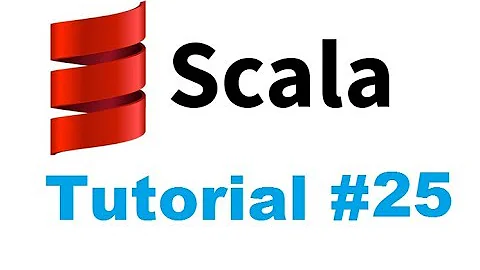difference between foldLeft and reduceLeft in Scala
Solution 1
Few things to mention here, before giving the actual answer:
- Your question doesn't have anything to do with
left, it's rather about the difference between reducing and folding - The difference is not the implementation at all, just look at the signatures.
- The question doesn't have anything to do with Scala in particular, it's rather about the two concepts of functional programming.
Back to your question:
Here is the signature of foldLeft (could also have been foldRight for the point I'm going to make):
def foldLeft [B] (z: B)(f: (B, A) => B): B
And here is the signature of reduceLeft (again the direction doesn't matter here)
def reduceLeft [B >: A] (f: (B, A) => B): B
These two look very similar and thus caused the confusion. reduceLeft is a special case of foldLeft (which by the way means that you sometimes can express the same thing by using either of them).
When you call reduceLeft say on a List[Int] it will literally reduce the whole list of integers into a single value, which is going to be of type Int (or a supertype of Int, hence [B >: A]).
When you call foldLeft say on a List[Int] it will fold the whole list (imagine rolling a piece of paper) into a single value, but this value doesn't have to be even related to Int (hence [B]).
Here is an example:
def listWithSum(numbers: List[Int]) = numbers.foldLeft((List.empty[Int], 0)) {
(resultingTuple, currentInteger) =>
(currentInteger :: resultingTuple._1, currentInteger + resultingTuple._2)
}
This method takes a List[Int] and returns a Tuple2[List[Int], Int] or (List[Int], Int). It calculates the sum and returns a tuple with a list of integers and it's sum. By the way the list is returned backwards, because we used foldLeft instead of foldRight.
Watch One Fold to rule them all for a more in depth explanation.
Solution 2
reduceLeft is just a convenience method. It is equivalent to
list.tail.foldLeft(list.head)(_)
Solution 3
foldLeft is more generic, you can use it to produce something completely different than what you originally put in. Whereas reduceLeft can only produce an end result of the same type or super type of the collection type. For example:
List(1,3,5).foldLeft(0) { _ + _ }
List(1,3,5).foldLeft(List[String]()) { (a, b) => b.toString :: a }
The foldLeft will apply the closure with the last folded result (first time using initial value) and the next value.
reduceLeft on the other hand will first combine two values from the list and apply those to the closure. Next it will combine the rest of the values with the cumulative result. See:
List(1,3,5).reduceLeft { (a, b) => println("a " + a + ", b " + b); a + b }
If the list is empty foldLeft can present the initial value as a legal result. reduceLeft on the other hand does not have a legal value if it can't find at least one value in the list.
Solution 4
For reference, reduceLeft will error if applied to an empty container with the following error.
java.lang.UnsupportedOperationException: empty.reduceLeft
Reworking the code to use
myList foldLeft(List[String]()) {(a,b) => a+b}
is one potential option. Another is to use the reduceLeftOption variant which returns an Option wrapped result.
myList reduceLeftOption {(a,b) => a+b} match {
case None => // handle no result as necessary
case Some(v) => println(v)
}
Solution 5
The basic reason they are both in Scala standard library is probably because they are both in Haskell standard library (called foldl and foldl1). If reduceLeft wasn't, it would quite often be defined as a convenience method in different projects.
Related videos on Youtube
Comments
-
 Rajesh Pitty almost 2 years
Rajesh Pitty almost 2 yearsI have learned the basic difference between
foldLeftandreduceLeftfoldLeft:
- initial value has to be passed
reduceLeft:
- takes first element of the collection as initial value
- throws exception if collection is empty
Is there any other difference ?
Any specific reason to have two methods with similar functionality?
-
samthebest over 9 yearsRecommend you see stackoverflow.com/questions/25158780/…
-
 pedram bashiri over 4 yearsWould be great if you edited the question to be "difference between fold and reduce in Scala".
pedram bashiri over 4 yearsWould be great if you edited the question to be "difference between fold and reduce in Scala".
-
Mansoor Siddiqui over 9 yearsGood answer. This also highlights why
foldworks on an empty list whilereducedoes not. -
socom1880 about 8 yearsCan you explain why
Bis a supertype ofA? It seems likeBshould actually be a subtype ofA, not a supertype. For example, assumingBanana <: Fruit <: Food, if we had a list ofFruits, it seems that that may contain someBananas, but if it contained anyFoods then the type would beFood, correct? So in this case, ifBis a supertype ofAand there is a list containing bothBs andAs, the list should be of typeB, notA. Can you explain this discrepancy? -
agilesteel about 8 yearsI'm not sure if I understand your question correctly. What my 5-year-old answer is saying about the reduce function is that a
List[Banana]can be reduced to a singleBananaor a singleFruitor a singleFood. BecauseFruit :> Bananaand `Food :> Banana'. -
socom1880 about 8 yearsYes... that actually does make sense thank you. I was originally interpreting it as "a list of type
Bananamay contain aFruit", which does not make sense. Your explanation does make sense -- theffunction being passed toreduce()can result in aFruitor aFood, which meansBin the signature should be a superclass, not a subclass.




